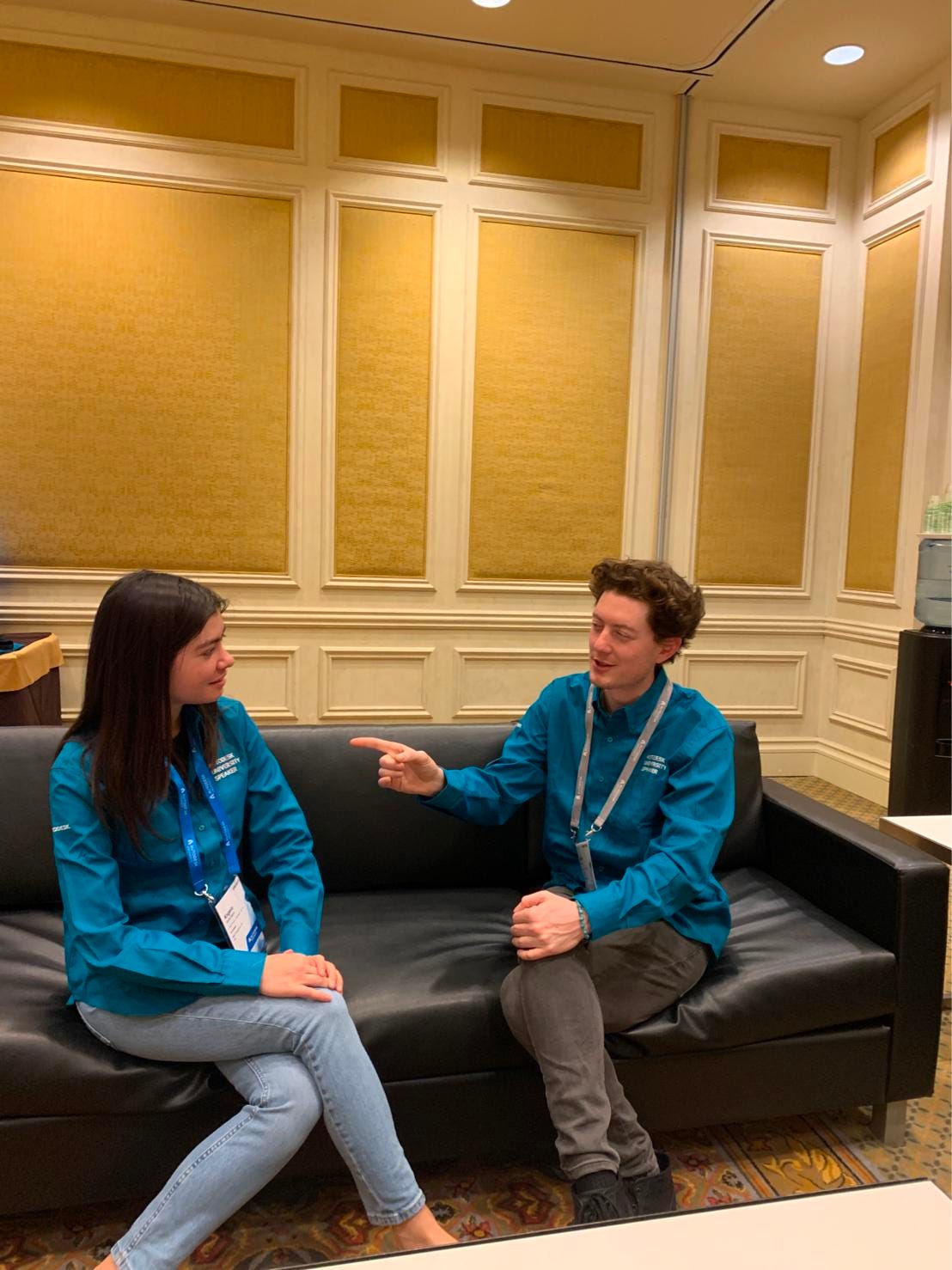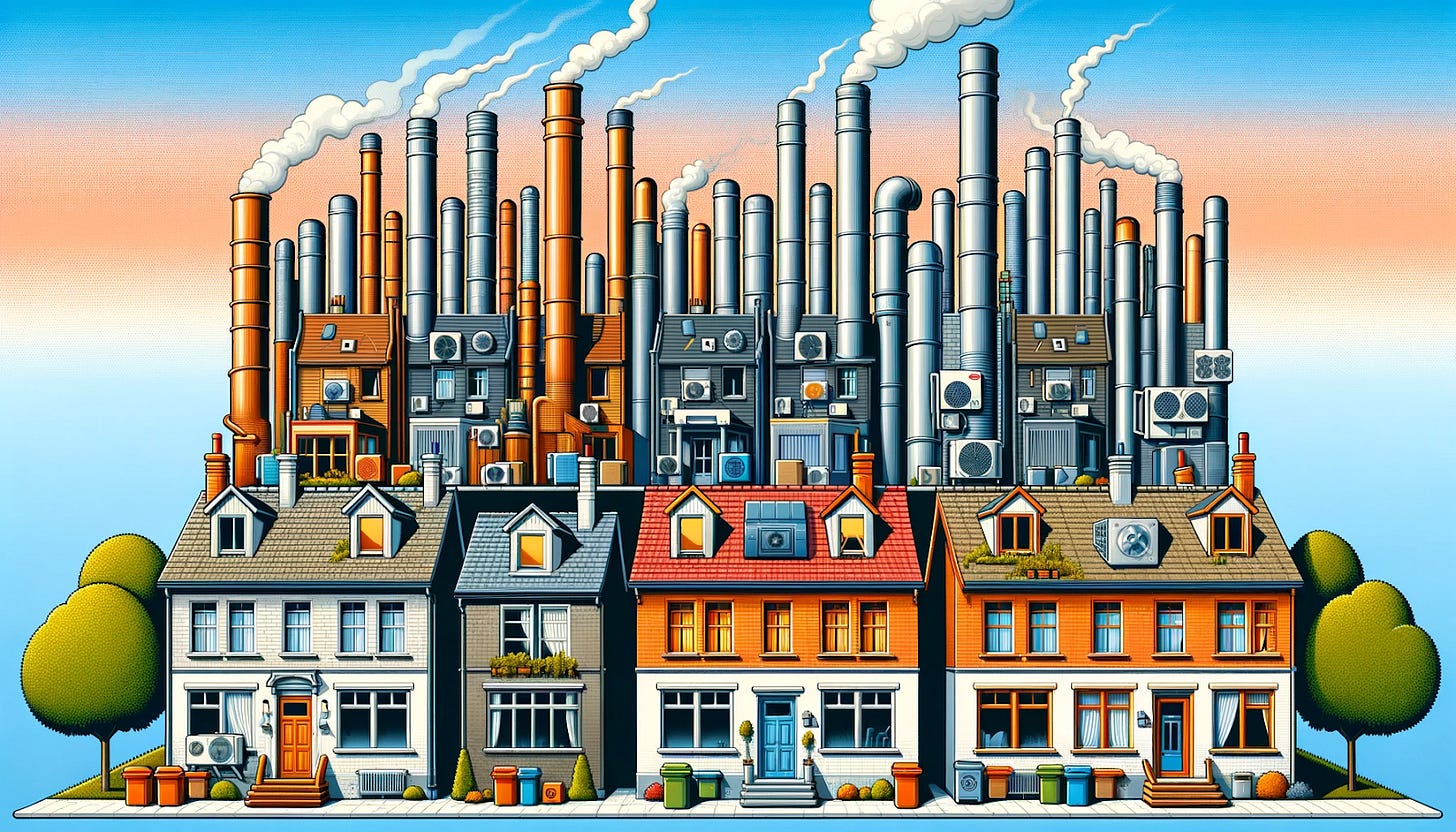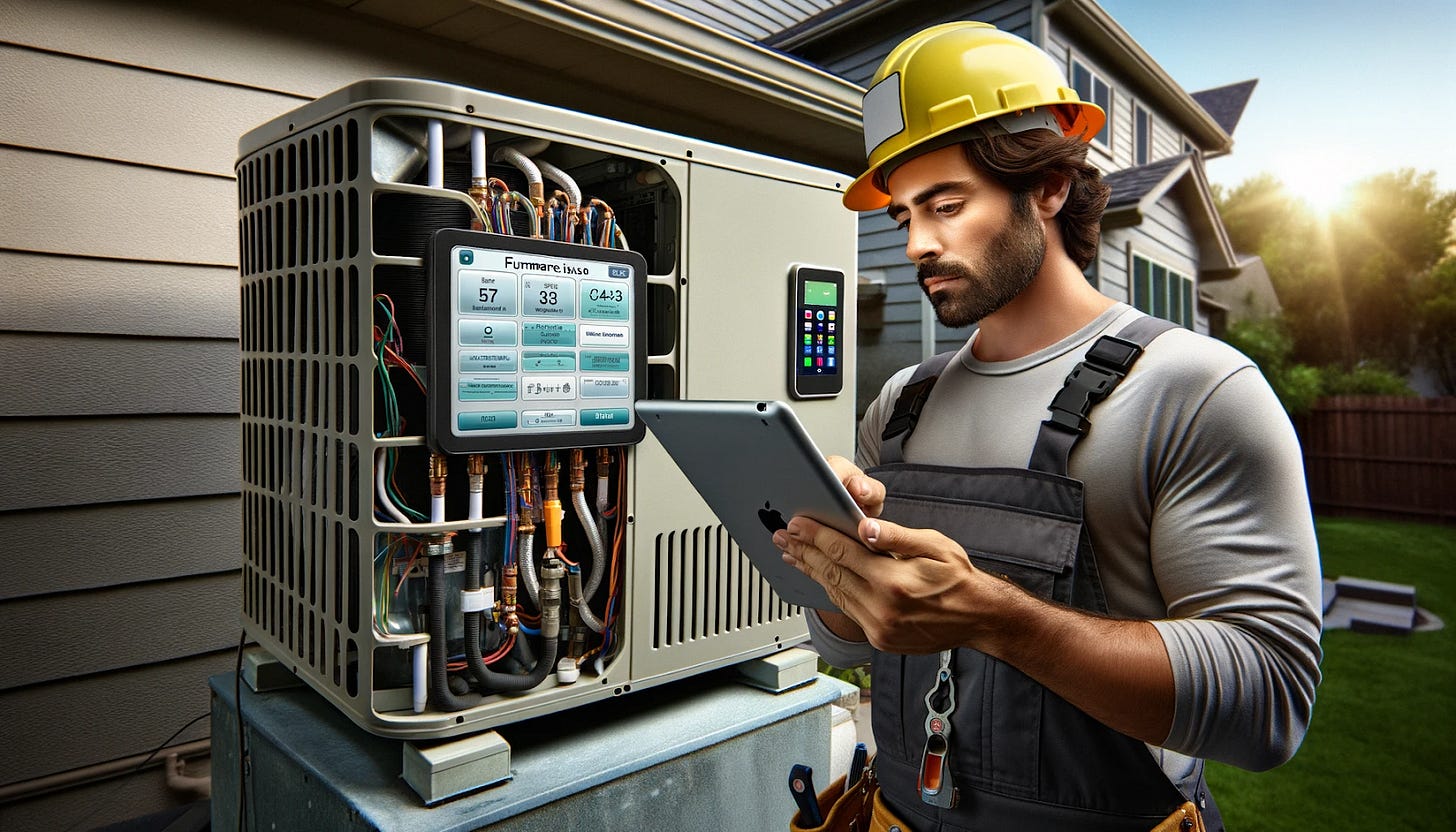Accelerating heat pump adoption through the increased supply of skilled labor #026
The supply of skilled labor is a bottleneck today to more energy efficient homes
👋 Matt here. I’m stoked to share Build in Climate’s second guest post! In this deep dive, Angela Santurbano focuses on the supply side of heat pumps. I first wrote about heat pumps 10 months ago and this is a great follow-up with more depth and new updates. Let’s dive in👇
TL;DR: Over the last two years, we’ve seen a huge jump in US homes with heat pumps. To further accelerate heat pump installations, start-ups should focus on increasing the supply side (e.g. contractors, equipment available) over getting more demand from consumers. This means improving the perception for high school students and workers entering the trades, increasing the scale of trade schools through technology, and digitizing contractor upskilling platforms. Finally, we also need more hardware innovation to improve efficiency and adapt to various physical layouts.
Before reading this deep dive, I recommend brushing up on the initial overview about heat pumps written by Matt in April 2023.
Angela in her own words
I’ve been passionate about the built environment since my foray into construction tech from 2017 to 2020. During that time, I worked closely with general contractors to digitize their preconstruction workflows and learned about their challenges in onboarding more skilled workers into their fields. Over the last 12 months, I’ve been exploring the intersection between the built environment and climate tech to understand how we can be carbon neutral in the construction and maintenance of our homes.

In the last few months, I’ve gone down a rabbit hole talking to dozens of HVAC contractors, trade schools, manufacturers, and climate tech founders to understand how heat pumps have evolved, how labor dynamics have shifted and how the software landscape has grown.
The world for heat pumps is continuing to grow - the next 10 years will continue to see scalable growth in the United States*.
As a child, I grew up in South East Asia in Singapore, China and Vietnam. I spent my youth taking xe oms (motorcycle taxis) in Hanoi, taking martial arts classes in Shanghai and first learning how to swim in Singapore when I was 4.
The weather during my time in Asia was humid and hot. The summers were sweltering: summers could peak at ~90F and the humidity hovered at 90%. This translated into a critical need for cooling systems. Twenty years later, I’m surprised how far ahead Asia was. For example, Japan boasts 90% of households having installed heat pumps in 2021. In comparison, only 15% of households in the United States used a heat pump in 2021.
That low penetration in the US is quickly changing. As of May 2023, the shipment of heat pumps to the US has risen 5.1% year over year, while the shipped volume of air conditioners fell. Heat pump sales overtook gas furnace sales the year before in 2022 (IEA).
The switch to heat pumps has become even more time sensitive. According to the IEA, the global heat pump stock will need to almost triple by 2030, to cover at least 20% of global heating needs and the United States has a goal of decarbonizing the economy by 2050. As HVAC equipment lasts on average 15 years, we will only be able to reach a fully decarbonized economy in 2050 if all new HVAC installations are heat pumps starting in 2035. That’s only ~10 years away. The need to transition is urgent and there’s a strong financial investments from the IRA’s and state subsidies to make it happen.
For this blog post, we will do a deep dive into two challenges and how start-ups can tackle them: 1) the labor shortage from the lack of skilled labor to install heat pumps at a reasonable price and 2) the quickly evolving knowledge that is required to work in heating and cooling.
Without further ado, let’s get into it.
1) We need to solve the skilled labor shortage problem to accelerate heat pump adoption
I believe that the biggest challenge to more heat pump adoption is the increased ability for contractors to install heat pumps, more than consumer awareness. Training and placing highly qualified contractors is the first step.
To accelerate heat pump adoption, we need to increase the number of HVAC contractors that can install and maintain heat pumps as opposed to increasing consumer awareness. Even if we have more homeowners that are interested in creating a sustainable self-reliant home and reduce their carbon footprint, if they can’t do that at an economically viable price point, they will continue to buy the more affordable short-term heating/cooling option for their homes.
Industry experts predict more than 400,000 HVAC technician job openings in the next 10 years alone. However, many roles are expected to stay unfilled, which contributes to high labor costs to switch HVAC equipment.
There are a couple of reasons for this labor shortage and we are barely scratching the surface: there aren’t enough high school graduates transitioning into jobs in the space because of poor brand perception of the trades, trade schools haven’t scaled to their platform enough to accommodate the volume of contractors needed in the next 5-10 years, and domain expertise is needed from contractors to handle IOT devices and electrical needs for heat pumps that today’s contractors haven’t been trained on.
Negative perception of the trades
The perception of entering the trades has changed as college has become ubiquitous. Having spoken to HVAC contractors in California, Illinois and Virginia, a big issue that I’ve regularly heard of is the lack of interest from high school students to enter the trades as a valid alternative to college. Skipping college and entering a blue collar job is perceived negatively with lower income opportunities.
However, perception is different from reality. Entering the trades has a higher income opportunity in the long run than getting a college degree. Average annual earnings for someone with a college degree is around ~$60k. Counterintuitively, going into the trades with a high school degree and an apprenticeship could bring in more an income ~$84k. That’s the average income for HVAC contractors. The median salary is ~$69k (still above $60k). And yet, most high school students view it as a bad career path. Driving awareness of this for high school students is critical to increase the potential labor entering the trades.
In addition, once the HVAC contractor gets their state license, they have the opportunity to run their own business and create generational wealth. These opportunities mean becoming a contractor might actually be more rewarding than going to college.
The reason for this high income opportunity is because demand is inelastic and we’re today facing a low supply of skilled contractors. No one will stop heating their house if their heater breaks down in the winter, even if the installation is too expensive. The high cost of labor and high upfront investment for a heat pump means a rational economic homeowner would choose a gas furnace or AC over a heat pump (without subsidies), as the heat pump has a higher initial upfront investment and only pays itself over time with lower utility bills.
We need more educational start-ups focusing on giving high school students awareness of these opportunities and creating an opportunity for apprenticeships with contractors.
Smaller scale of today’s trade schools
The best way to enter the field is through a union apprenticeship. On average, unions command a higher wages and more job opportunities. However, unions can only take in so many students. Looking at the adjacent industry of construction, in 2019, only 12.6% of contractors were unionized. Private trade schools take on the rest of the industry’s need to train and onboard the next generation of contractors.
Today, scaling up vocational training is slow and apprenticeships are hard to find. The poor adoption of digital platforms by trade schools is partially to blame. Today’s private trade schools are entirely service-based, utilizing instructors for each class who build up their own curriculum. For example, a Chicago trade school director trains ~40 students per class and has two classes a year because each class is in person. With a lack of digital platforms and virtual learning on VR platforms, it becomes harder to scale up the number of students per class and upskill contractors each year to install heat pumps. Interplay Learning is a company that is leaning in to provide trade school training programs through VR programs to help students run through various different scenarios of fixing HVAC equipment and is gaining traction in the trades.
These are a few start-ups focused on helping increase the talent supply to accelerate the transition to heat pumps are. They focus on a combination of a labor marketplace to match employees with employers, upskilling through digital upskilling for employees and increasing employee productivity for employers.
Classet, Faraday, illu, Interplay Learning, Smalt, Upsmith
Additional domain expertise required from today’s contractors
In addition to onboarding new HVAC contractors, we also need to upskill today’s labor with the new skill sets required to handle heat pumps. Skilled contractors will need to master electrifying homes and hire a licensed electrician as well as understand software as IOT devices become prevalent.
As an HVAC contractor, installing heat pumps requires understanding the theory of electricity and tactically, understanding if an electrical panel upgrade is needed. Older homes, even homes that were only built 20 years ago, have electrical panels that only run 100 amps. The electricity needs were minimal when homes ran on natural gas. However, moving from a gas furnace to a heat pump draws a lot more electricity. Depending on the house, this will require electrical panel upgrades to 200 amps. This upgrade could mean an additional cost of $6k, and up to $15k if you’re in the Bay Area to account for labor costs. Homeowners need to work with a licensed electrician to upgrade the electrical panel when homes are outdated. Therefore, HVAC contractors now need to have that electrical knowledge and a licensed electrician on their team. This is pushing some contractors to consolidate their businesses to provide both HVAC and electrician services to accommodate the heating and cooling needs of homeowners.
As equipment evolves, contractors will need to feel comfortable with software. Large manufacturers have improved analog devices to become more adaptable by building a software and firmware layer that controls the IOT devices.
Some of the most experienced contractors have gained their knowledge over a 40-year career however when they started, they only needed to fix and troubleshoot equipment by hand. In the past, they would have needed to be adept with their hands, understanding how thermodynamics work tactically, and making sure they were handling refrigerants correctly.
As heat pumps become more powerful with IOT interfaces, highly experienced contractors with long careers need to be upskilled to understand all three layers of a heat pump: the software to manage settings and tweak heating/cooling preferences, firmware to diagnose any issues with the equipment and hardware if the equipment itself has failed.
In addition, we need more hardware start-ups in the space of home electrification to accelerate the volume of energy efficient heat pumps, beyond today’s largest manufacturers such as Carrier, Daikin, and Mitsubishi.
2) We need more hardware innovation to decarbonize
In the last 30 years, venture capital focused on investing in software: start-ups could scale software products fast with low unit costs and potential for 100x returns. However, with the lower cost of entry for new start-ups to build software and an oversaturation of the software landscape, venture capitalists have adjusted their return expectations and are looking at investments in hardware. This is a win-win situation since climate tech needs further investment in innovative hardware to reduce the amount of GhG emitted.
One place for start-ups to lean in is creating more efficient heat pumps. In the heating and cooling world, there’s an important metric called COP that measures efficiency: Coefficient of performance. A heat pump with a COP of 5.0 generates 5kW of heat from a 1kW electrical input. Gas furnaces, on the other hand, operate at around a COP of 1. Generally the latest generation of heat pumps are more energy efficient and operate at a COP of 3-5. However, they can continue to increase their efficiency as heating and cooling needs continue to increase globally.
We also need more heating/cooling equipment to fit various physical environments, from large open rooms to narrow and tiny apartments. For example, Gradient has innovated in the window-ledge heat pump for small apartments that New Yorkers are all too familiar with.
As we innovate with hardware, pairing heat pumps with a smart device that lets you control temperature at home, and control energy usage through a smart electrical panel, we can make homes more efficient.
There’s a few start-ups focused on building new hardware with a simple and intuitive software layer. Kapacity focuses on smart metering, Span.io focuses on IOT electrical panels and Quilt, Gradient, Helios that focus on innovative heat pumps and an accelerated installation process.
3) While start-ups are effective in innovating for contractor workflows, they are less effective in building consumer awareness for heat pumps
While start-ups use fast experimentation and innovation to positively disrupt the built environment, they aren’t as effective at creating universal standard consumer awareness nor standardizing heat pump labels to influence purchasing decisions as they can only influence a small segment of consumers purchasing their product rather than the general population.
Today, most household consumers want a sustainable way of cooling and heating their homes; however, they don’t have a strong understanding of heat pumps or how to choose the right heat pump. It’s easy to misunderstand that heat pumps don’t only provide heat, but also cooling.
Consumer education campaigns for homeowners run by government and state agencies are important to understand the benefit of heat pumps and the considerations when purchasing a heat pump to provide standard terminology and common understanding through big campaigns.
Some states have done a great job building heat pump awareness, creating websites where consumers can understand the benefits of a heat pump, rebates available and contractors who can install the heat pump. New England has some state agencies that are leading the effort: MassSave for Massachusetts, NYSERDA in New York and Efficiency Maine in Maine provide customer education, financial options available for homeowners and contractors that can be contacted for installation.
In addition, the government needs to step in to rectify certain misperceptions around heat pumps. After having spoken to different house owners, there’s still a common myth that heat pumps don’t work efficiently in cold weather as previous generations haven’t been efficient in colder winters. However, heat pumps have become highly efficient and a lot more operable in cold climates since the last generation.
Government agencies can step in to build more consumer awareness and build a foundational understanding of efficient heating and cooling systems while rectifying common misperceptions of heat pumps.
Government agencies can also raise minimum efficiency standards and publish more guidance for consumers on the single best label to use when purchasing HVAC equipment as there are multiple labels that cause consumer confusion as to which one to use when purchasing their heating/cooling unit: the EnergyStar rating, the heating season performance factor (HSPF), or the seasonal energy efficiency ratio (SEER).
Standardizing labeling across various pieces of equipment requires manufacturers to gather data and translate it to energy usage and innovate to increase energy efficiency. To keep manufacturers accountable and to help consumers choose an HVAC system, government can step in to keep manufacturers accountable to ensure that manufacturers are in fact using the right standardized label and penalize them if they knowingly use the wrong label or omit them entirely.
The SEER 2 label is the label encouraged by the DOE that is used to manufacture new units in 2023 and onward and will ideally make it easier for consumers to compare not only amongst heat pumps but also with other HVAC equipment that they might consider. To drive conformity, starting in 2023, government entities should require the clear placing of SEER 2 labels on all HVAC equipment for consumers to be able to use it to compare and choose a performant air conditioner, gas furnace, or heat pump.
There’s a big opportunity for new startups within the built environment and in particular in the heat pump space. There are certain challenges that start-ups are particularly adept at tackling: namely helping the labor shortage of skilled installers and technicians and upskilling existing labor in the space.
On the other hand, there are other areas that are tarpit ideas for start-ups, namely focusing on consumer education and awareness or creating labeling standards for equipment.
I’d love to chat if you’re an engineer or data scientist passionate about decarbonizing the built environment and meeting more fellow builders in the home services / contractor space. Feel free to email me at angela.santurbano@gmail.com.
* : For this article, I focused on air-to-air heat pumps that provide heating and cooling needs for a home. This is the biggest opportunity where the technology is proven, the manufacturing volume has increased to support demand and the pricing is on the right trajectory to become widely accessible for consumers.







